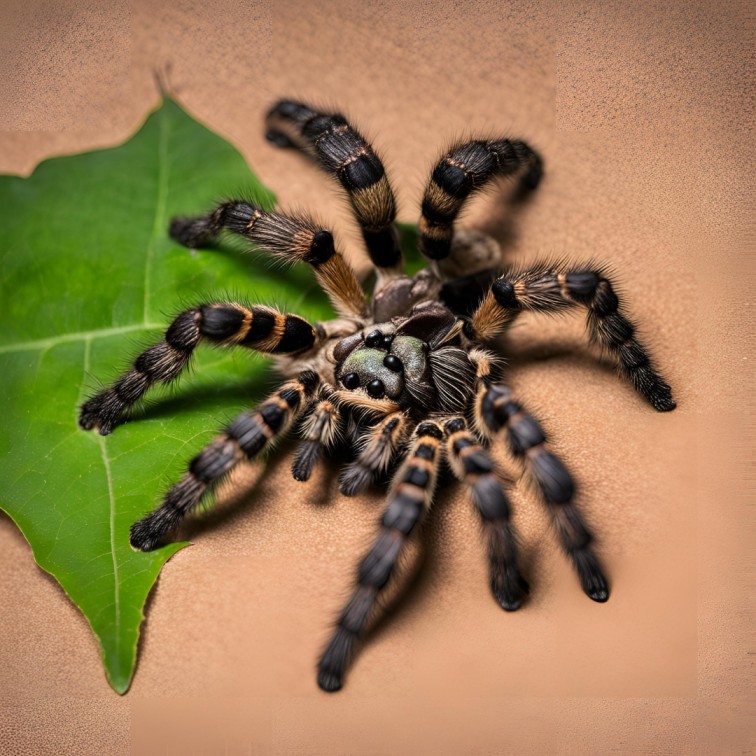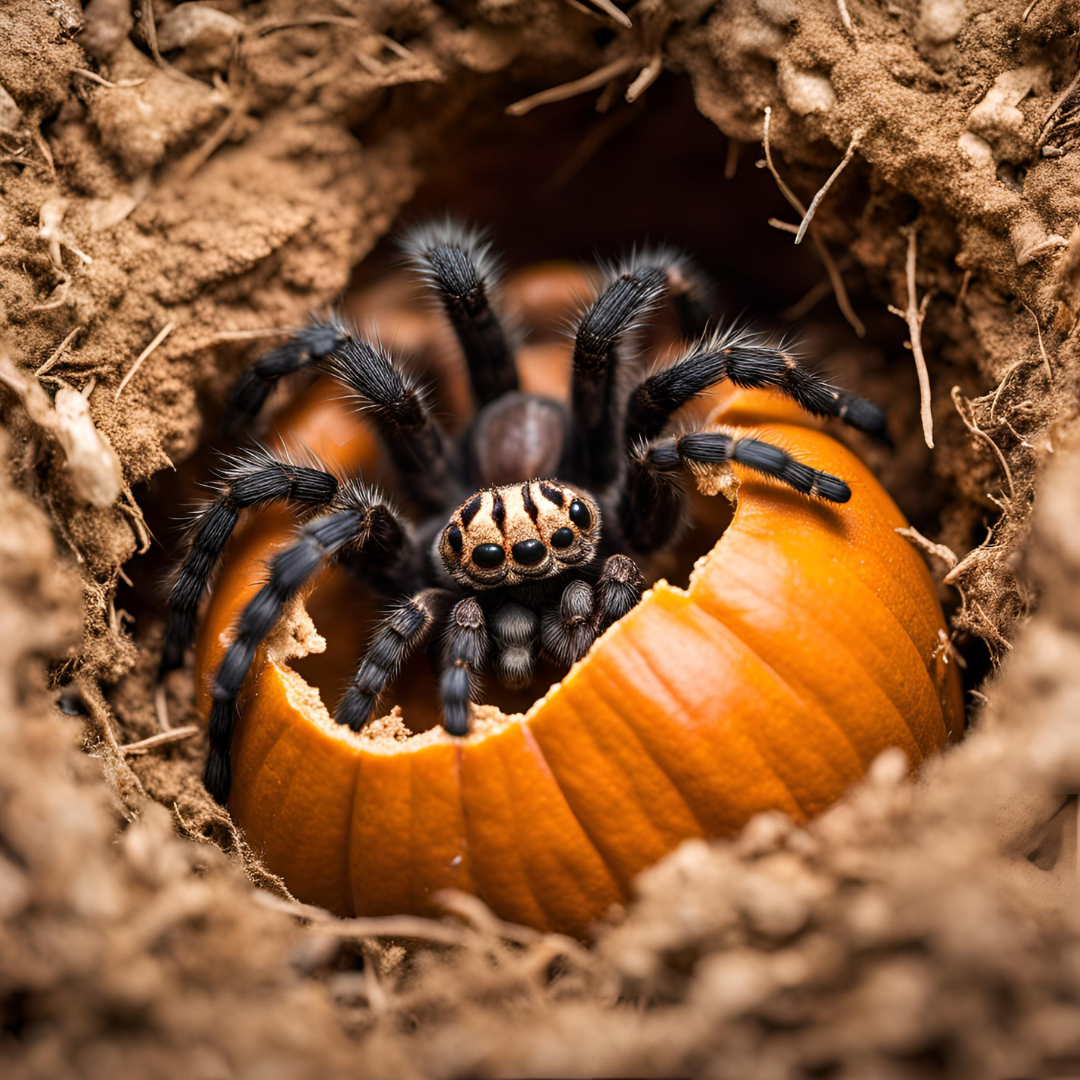Introduction
Table of Contents
The world of tarantulas is full of amazing and diverse species, but few are as captivating and distinctive as the pumpkin patch tarantula. With its vibrant colors and small stature, this spider has become a favorite among tarantula enthusiasts and pet keepers alike. In this comprehensive guide, we’ll dive deep into the life of the pumpkin patch tarantula, exploring everything from its natural habitat and behavior to tips on how to care for it as a pet. Whether you’re a curious beginner or a seasoned tarantula lover, this article will provide you with a wealth of information about these fascinating creatures.

What is a Pumpkin Patch Tarantula?
Overview
The pumpkin patch tarantula (Hapalopus sp. Colombia) is a small, brightly colored spider native to Colombia. It belongs to the Theraphosidae family, which includes over 900 species of tarantulas worldwide. What sets the pumpkin patch tarantula apart is its striking orange and black pattern, which resembles a pumpkin patch, hence the name.
Key Features
- Scientific Name: Hapalopus sp. Colombia
- Common Name: Pumpkin Patch Tarantula
- Size: Adults typically have a leg span of 2-3 inches.
- Coloration: Bright orange and black, with distinctive patterns that vary among individuals.
- Lifespan: Females can live up to 10 years, while males usually live 2-3 years after maturity.
Natural Habitat
Geographic Distribution
The pumpkin patch tarantula is indigenous to Colombia, a country known for its rich biodiversity. These tarantulas are typically found in the tropical forests of Colombia, where the climate is warm and humid year-round.
Habitat Characteristics
In their natural environment, pumpkin patch tarantulas prefer areas with plenty of ground cover, such as leaf litter, logs, and branches. These environments provide them with the perfect conditions for burrowing and hiding from predators.
Climate
- Temperature: These tarantulas thrive in temperatures ranging from 75-80°F.
- Humidity: They require a high humidity level, usually between 70-80%, which is typical of tropical forest environments.
Physical Characteristics
Size and Appearance
The pumpkin patch tarantula is one of the smaller tarantula species, with adults reaching a leg span of about 2-3 inches. Despite their small size, they are known for their vibrant and eye-catching coloration. The carapace (the top part of their body) is a bright orange, often with intricate black markings. Their legs are also dark, usually black or brown, with orange bands that create a striking contrast.
Coloration and Patterns
The orange and black pattern on the pumpkin patch tarantula is not just for show; it serves as a form of camouflage, helping them blend into the forest floor among the fallen leaves and debris. This coloration also acts as a warning to potential predators about their venomous capabilities.
Molting Process
Like all tarantulas, the pumpkin patch tarantula undergoes molting, a process where they shed their old exoskeleton to grow. Molting is crucial for their growth and can occur several times a year in young tarantulas, but less frequently as they age.
Behavior and Lifestyle
Burrowing Habits
The pumpkin patch tarantula is a prolific burrower. In the wild, they dig complex burrow systems that provide them with shelter and a place to ambush prey. These burrows can be quite elaborate, with multiple chambers and entrances.
Nocturnal Lifestyle
Pumpkin patch tarantulas are primarily nocturnal, meaning they are most active during the night. This nocturnal lifestyle helps them avoid daytime predators and also takes advantage of the cooler, more humid conditions at night, which are ideal for their survival.
Diet and Hunting Techniques
In their natural habitat, pumpkin patch tarantulas are opportunistic feeders. They primarily hunt insects and other small invertebrates, using their speed and stealth to capture prey. In captivity, they can be fed a diet of crickets, mealworms, and other small insects.
Temperament
Despite their formidable appearance, pumpkin patch tarantulas are generally docile and shy. They prefer to retreat to their burrows rather than confront threats. However, like all tarantulas, they can become defensive if provoked.
Caring for a Pumpkin Patch Tarantula
Enclosure Setup
Creating a suitable habitat for a pumpkin patch tarantula in captivity involves mimicking their natural environment as closely as possible. Here’s what you’ll need:
- Tank Size: A small tank, around 5-10 gallons, is sufficient.
- Substrate: Use a deep layer of coconut fiber or peat moss to allow for burrowing.
- Humidity: Maintain a humidity level of 70-80% by misting the tank regularly.
- Temperature: Keep the tank at a steady temperature between 75-80°F.
- Hiding Places: Provide plenty of hides, such as small logs, bark, or artificial caves.
Feeding
Pumpkin patch tarantulas are not picky eaters, but it’s important to provide a balanced diet:
- Insects: Feed them a variety of live insects such as crickets, mealworms, and roaches.
- Feeding Frequency: Juveniles should be fed more frequently, about 2-3 times a week, while adults can be fed once a week.
Handling and Interaction
While pumpkin patch tarantulas are generally docile, they are also very fast and can be easily startled. It’s best to limit handling to avoid stressing them out. When handling is necessary, do so gently and carefully.
Health and Maintenance
- Molting: Monitor your tarantula during the molting process and avoid disturbing them.
- Hydration: Ensure they have access to a small water dish, and keep the humidity at appropriate levels.
- Tank Cleaning: Regularly clean the enclosure to prevent mold and mites.
Breeding Pumpkin Patch Tarantulas
Breeding Behavior
Breeding pumpkin patch tarantulas can be challenging but rewarding. Males typically reach maturity faster than females and will begin looking for a mate. During the mating process, the male will perform a series of taps and vibrations to attract the female.
Egg Sac and Spiderlings
Once mating is successful, the female will lay an egg sac, which she guards closely. The eggs will hatch into spiderlings after several weeks. The spiderlings can be separated and raised individually or left with the mother until they are larger.
Challenges and Considerations
Breeding tarantulas requires patience and careful observation. It’s important to ensure that both the male and female are healthy and that their environment is conducive to breeding.
Common Health Issues and Solutions
Molting Problems
Molting is a critical process for tarantulas, but it can sometimes lead to issues such as incomplete molts or molting complications. To prevent molting problems, ensure that your tarantula’s enclosure has the right humidity levels and that they have a stress-free environment.
Dehydration
Pumpkin patch tarantulas need a humid environment to stay hydrated. Signs of dehydration include shriveled bodies and lethargy. Make sure your tarantula has access to fresh water and maintain proper humidity levels in their enclosure.
Parasitic Infections
Parasitic mites can be a problem for tarantulas. Regularly clean the enclosure and inspect your tarantula for any signs of mites. If you notice mites, isolate your tarantula and thoroughly clean their habitat.
Comparing Pumpkin Patch Tarantulas to Other Tarantulas
Size and Growth Rate
Compared to larger tarantula species like the Goliath bird-eater, the pumpkin patch tarantula is relatively small and grows at a moderate rate. This makes them easier to manage in captivity.
Temperament
Pumpkin patch tarantulas are known for their docile nature, making them a good choice for beginners. In contrast, some other species can be more aggressive and difficult to handle.
Care Requirements
While pumpkin patch tarantulas have specific care requirements, they are generally easier to care for than some of the more exotic species. Their small size and less aggressive nature make them a popular choice among tarantula enthusiasts.
Why Pumpkin Patch Tarantulas Make Great Pets
Low Maintenance
Pumpkin patch tarantulas are relatively low-maintenance pets. They don’t require frequent feeding or cleaning, and their enclosure can be simple and easy to manage.
Fascinating to Observe
With their vibrant colors and interesting behaviors, pumpkin patch tarantulas provide hours of fascination. Watching them hunt, burrow, and even molt can be a rewarding experience for pet owners.
Ideal for Beginners
Due to their docile nature and straightforward care requirements, pumpkin patch tarantulas are ideal for those new to keeping tarantulas. They are a great introduction to the world of tarantula keeping.
Tips for New Tarantula Owners
Do Your Research
Before getting a pumpkin patch tarantula, make sure you understand their needs and care requirements. Researching ahead of time will help you provide the best possible care for your new pet.
Start with a Simple Setup
A simple, well-maintained enclosure is all you need to start. Focus on providing a suitable substrate, proper humidity, and hiding places for your tarantula.
Handle with Care
Limit handling to avoid stressing
your tarantula. When you do need to handle them, do so gently and with care to prevent any injuries.
Be Patient
Tarantulas can be shy and may take some time to adjust to their new environment. Be patient and give them time to settle in.
FAQs
- What does a pumpkin patch tarantula look like?
- The pumpkin patch tarantula has bright orange and black patterns, resembling a pumpkin patch.
- How long do pumpkin patch tarantulas live?
- Females can live up to 10 years, while males usually live for 2-3 years after reaching maturity.
- Are pumpkin patch tarantulas suitable for beginners?
- Yes, they are ideal for beginners due to their docile nature and straightforward care requirements.
- What do pumpkin patch tarantulas eat?
- They primarily eat insects like crickets, mealworms, and roaches.
- How do I set up a tank for a pumpkin patch tarantula?
- Use a small tank with a deep substrate, maintain humidity, provide hiding places, and keep the temperature between 75-80°F.
Conclusion
The pumpkin patch tarantula is a remarkable spider that captivates with its vibrant colors and intriguing behaviors. Whether you’re considering getting one as a pet or simply want to learn more about these fascinating creatures, the pumpkin patch tarantula is sure to enchant and educate. With proper care and attention, these tarantulas can make wonderful and low-maintenance pets that bring a bit of the wild into your home.

